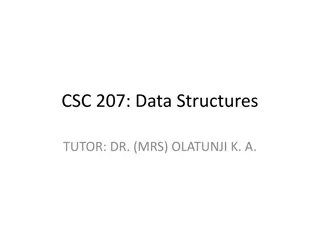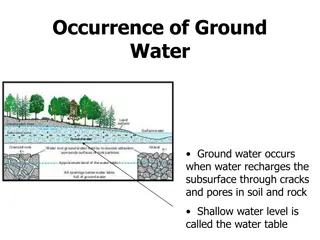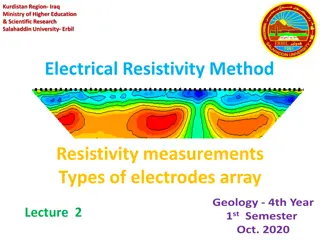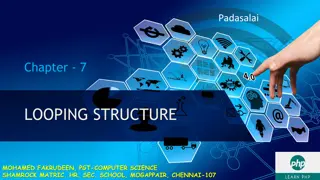Principles of Management
This module explores common organizational structures, the purpose of organization, factors in organizational design, current trends, and the advantages and disadvantages of various structures. It covers specialization, division of labor, hierarchy of authority, centralization, decentralization, for
0 views • 23 slides
Europa: Icy Moon of Jupiter and the Potential for Life
Europa, Jupiter's icy moon, offers fascinating insights into its composition, subsurface oceans, and potential for hosting extremophiles. Explore the geology, chaos terrain, and interaction between the ocean and crust. Could there be life on Europa? Learn how salt affects water freezing points and t
2 views • 12 slides
Composition of Earth's Oceans
Delve into the composition, location, and subsurface topography of the world's oceans, discovering the chemical makeup of ocean water and its vast salt content. Uncover fascinating facts such as how the salt in the oceans could create a 500-foot thick layer if spread over Earth's land surface. Engag
2 views • 16 slides
Market Structures and Competition Overview
Market structures in economics define the competitive characteristics of different markets. Perfect competition features many small firms producing identical products as price takers. Monopoly has one seller with significant market power, while monopolistic competition involves firms with some marke
4 views • 5 slides
Effective Coordinating Structures for Response Operations
Operational coordination involves actions and activities to enable decision-makers to determine appropriate courses of action for various incidents, including homeland security operations. Coordinating structures help organize response efforts to address mission requirements, improve access to resou
3 views • 19 slides
Subsurface Structures of Pit Craters Through Seismic Reflection
Discover the technique of seismic reflection imaging to unveil the subsurface structures of pit craters on Earth and Mars. Follow the analysis of seismic data to map pit craters and their connections to geological features like dykes and fault jogs, shedding light on the formation processes of these
1 views • 11 slides
Data Structures in CSC 207 with Dr. Olatunji K. A.
This course covers the objectives, learning outcomes, and contents related to data structures in CSC 207. Students will learn about data type specifications, representation techniques, algorithm analysis, recursive methods, and practical applications of data structures. The course delves into basic
1 views • 22 slides
Groundwater: Occurrence, Recharge, and Movement
Groundwater occurs when water seeps into the subsurface through cracks and pores in rocks and soil, forming the water table. Recharge happens naturally through processes like precipitation and snowmelt, as well as artificially through methods like recharge wells and water spread over land. The movem
2 views • 8 slides
Geophysics Field Testing Workshop: Methods and Interpretation
This workshop on geophysics field testing covers a range of methods such as downhole and surface testing, spectral analysis, seismic refraction, and more. Geophysical investigations help assess subsurface properties efficiently and non-invasively, offering valuable insights for site exploration and
1 views • 16 slides
Control Structures in Programming
Control structures in programming allow programmers to manage the flow of execution with selection/decision and repetition/loop structures. This chapter explores different types of selection control structures like if, if-else, nested if-else, and switch-case statements, providing examples and exerc
2 views • 30 slides
Exploring Trees Data Structures Using C - Second Edition
Learn about trees data structures in the context of programming using the C language. This comprehensive guide covers topics such as types of trees, tree creation, traversal, basic terminologies, and different tree structures like binary trees and binary search trees. Dive into the world of trees da
2 views • 54 slides
Data Structures: A Comprehensive Overview
Data structures are schemes for organizing data in a computer's memory, influencing program performance. Common structures like queues and binary trees are outlined, illustrating their organization and use cases. The choice of data structures impacts task efficiency, with programmers analyzing data
0 views • 20 slides
Resistivity Measurements in Geology
Explore the concept of resistivity measurements in geology, focusing on electrode configurations such as Wenner and Schlumberger arrays. Learn about the potential differences in electrode setups and how to calculate apparent resistivity through geometrical factors. Various electrode arrangements and
0 views • 22 slides
Design of Head Works and Canal Structures - Learning Objectives and Evaluation
This course covers the design concepts, principles, methods, and procedures related to the design of irrigation head works and canal structures. Topics include irrigation network layout, diversion head works design, seepage analysis methods, protection works, canal profile design, canal head regulat
0 views • 4 slides
Vertical Flow Constructed Wetland Technical Specifications and Requirements
The technical specifications for a vertical flow constructed wetland include requirements for subsurface compacting, lining materials such as clay layers and plastic liners, perforation of pipes, watertight installation of underdrain pipes, central drainage channel design, and filter media compositi
0 views • 11 slides
RCRL Prospective Research Directions in Carbonate Reservoir Characterization
The RCRL group at the University of Texas at Austin specializes in research on carbonate reservoirs at various scales, from nanopores to basin architecture. They focus on developing predictive relationships and tools for reservoir characterization based on subsurface datasets and outcrop analogs. Th
1 views • 12 slides
x86-64 Procedures and Data Structures
This content provides insights into x86-64 programming, covering topics such as procedures, integer registers, stack frames, locals in the red zone, interesting features of stack frames, arrays, multi-dimensional structures, and more. It dives into the usage conventions of integer registers, the all
1 views • 44 slides
Remote Control of ATV Team with myRIO and Shared Variables
Developing a remote control system for an ATV team using myRIO to manage functions like steering, throttle, choke, brakes, and start/stop via WiFi communication. Components like Haydon Motor Controller, Sabertooth 2x25 for steering, relays for brakes/start/stop, and shared variables enable efficient
0 views • 13 slides
Innovative Resistive Layers and Structures for Particle Detection at CERN
Explore the latest advancements in resistive layers and structures designed for particle detection at CERN. The research covers various types of resistive structures, including GEM and BULK Micromegas, and delves into topics such as spark protection, energy levels, and material vaporization. Detaile
0 views • 39 slides
Looping Structures in PHP
Looping structures are essential in programming for writing iteration logics. This article delves into the importance of looping structures, different types in PHP, and creating basic logic using loops like for, while, for each, and do-while. Learn the syntax, parameters, examples, and flow charts t
0 views • 23 slides
Mix and Match Data Structures for Efficient Algorithms
Discover how to combine basic data structures like arrays, linked lists, and trees to create specialized data structures for various applications. Explore the concept of mix-and-match data structures with multiple organizations to implement efficient algorithms like adjacency lists and matrices for
0 views • 12 slides
Sludge Drying Beds Technical Specifications and Requirements
This document outlines the technical specifications and requirements for sludge drying beds. It covers aspects such as subsurface compacting, lining materials, underdrain pipes, filter media, and slabs. The beds are designed with specific slopes for drainage efficiency and proper placement below gro
0 views • 6 slides
Ventura County ISDS Construction Examples Slideshow
This slideshow showcases different construction stages of Individual Sewage Disposal Systems (ISDS) in Ventura County, providing an overview of the types of systems allowed and general construction techniques employed. From the installation of pressurized distribution beds to completed mounds with l
0 views • 15 slides
Surface Wave Dispersion in Seismic Exploration
Surface wave dispersion, explored by James Crane and Bolu Owolana, plays a crucial role in seismic studies. This phenomenon, involving waves spreading at varying speeds, helps evaluate subsurface characteristics based on wavelength. By studying surface waves, researchers can determine velocity, dens
0 views • 14 slides
Operational Ocean Modeling and Forecasting Systems
This content provides an overview of various operational ocean modeling and forecasting systems, including data assimilation processes, glider data, surface and subsurface data sources, forecasting models for hurricanes, and NOAA's hurricane forecasting models. It covers a range of technologies and
1 views • 16 slides
Multiphase Flows in the Upstream: A Comprehensive Overview
This content delves into the complexities of multiphase flows in the upstream sector, covering topics such as reservoir management, drilling, subsurface imaging, and reservoir modeling. It explores the challenges of multi-scale phenomena, multi-physics interactions, uncertainty, and inversion in the
0 views • 4 slides
Performance Analysis of Synchronization Methods in Concurrent Data Structures
Explore the impact of synchronization methods on the performance and behavior of concurrent data structures in multithreaded applications. The study involves developing and implementing concurrent data structures, analyzing coarse-grain locking, fine-grain locking, lock-free mechanisms, and assessin
1 views • 25 slides
Insights on Ocean Climate Change: Observations and Implications
Observations in this chapter highlight significant changes in ocean properties related to climate over the past 40 years. These changes include shifts in temperature, salinity, sea level, carbon levels, pH, and oxygen content. The patterns of change observed suggest a link between surface and subsur
0 views • 35 slides
Innovative Solution for Heat Storage Using Aquifers
Heat storage is crucial, especially during winter, and aquifers present a viable solution. By utilizing subsurface as an insulator and tapping into tertiary sand deposits, applications for shallow and deep geothermal energy are feasible. The concept of a Hot Water Battery offers an efficient means o
0 views • 12 slides
Structures and Unions in C Programming
Exploring the concept of structures and unions in the C programming language, this reference material covers their definition, initialization, assignment, members, arrays, and nested structures. Learn how structures aggregate data types and how unions can share memory locations. Gain insights into s
0 views • 20 slides
Single Layer Structures with Cube Conversations
Dive into the exploration of single-layer structures with Cube Conversations. Discover different perspectives on visualizing these structures and uncover various ways to analyze and think about them. Engage in critical thinking and problem-solving to understand the composition of unit cubes in the g
0 views • 5 slides
Cost Analysis and Reporting Enhancement (CARE) for Oil Sands Royalty Business
Enhance your oil sands royalty business with the Cost Analysis and Reporting Enhancement (CARE) program by Alberta Energy. CARE assists in assessing the effectiveness of the Royalty Regime, supports policy development, strategic planning, and forecasting processes. It provides project assessment, tr
0 views • 45 slides
Radiative Transfer and Volume Path Tracing
Explore the mathematical model of radiative transfer for simulating light scattering in participating media and translucent materials through volume path tracing. Learn about subsurface scattering and how radiance changes along ray segments in participating media. Delve into the origins and applicat
0 views • 44 slides
Satellite Applications in Estimating Earth's Surface Energy Budget
Satellites play a crucial role in estimating the Surface Energy Budget (SEB) by providing data on various components such as Surface Radiation Budget and Surface Turbulent Fluxes. The SEB includes factors like net radiation flux, sensible and latent heat fluxes, and subsurface heat transfer. Satelli
0 views • 38 slides
Resonance Phenomena in Grating Structures and Applications
Resonance phenomena in grating structures, such as dielectric or metal gratings on substrates, offer sensitive elements for detecting biological and chemical agents. The sensitivity of these structures is described by equations relating to resonant wavelength changes and the refractive index of inve
0 views • 20 slides
Development of Fetal Head and Neck Structures in Week 12
The fetal head and neck structures in week 12 exhibit a complex formation process involving contributions from all three embryonic layers and the neural crest. Neural crest plays a significant role in developing jaw skeletal elements, connective tissues, and tendons. The pharynx, starting at the buc
0 views • 30 slides
Classification of Discontinuities in Metal Processing
Classification of discontinuities in metal processing involves identifying interruptions in the normal physical structure, such as cracks, seams, and inclusions, which may or may not be defects. Discontinuities can be surface or subsurface, with surface ones being more likely harmful. The origins of
0 views • 29 slides
Deciphering Climate Variability Through Ocean Buoys Data Collection
Ocean buoys like TAO/TRITON provide valuable data on climate variability by measuring various parameters like sea-surface temperature, wind speed, humidity, and subsurface temperatures. Anomalies from normal conditions help identify patterns over time, aiding in understanding climate changes. Mainta
0 views • 5 slides
Data Structures and Abstract Data Types in Computational Thinking
Data organization and abstraction play a crucial role in computational thinking. Data structures like fasteners exemplify how different types of operations are associated with distinct characteristics. Abstract Data Types (ADTs) serve as specifications for data structures, outlining their essential
0 views • 17 slides
Overview of Bloom Filters and Succinct Data Structures
Bloom filters and succinct data structures are efficient data structures used for set-membership tests and approximate queries. Bloom filters offer compact storage for set membership with a trade-off in accuracy, while succinct data structures aim to balance high performance, low space cost, and sup
0 views • 22 slides







































